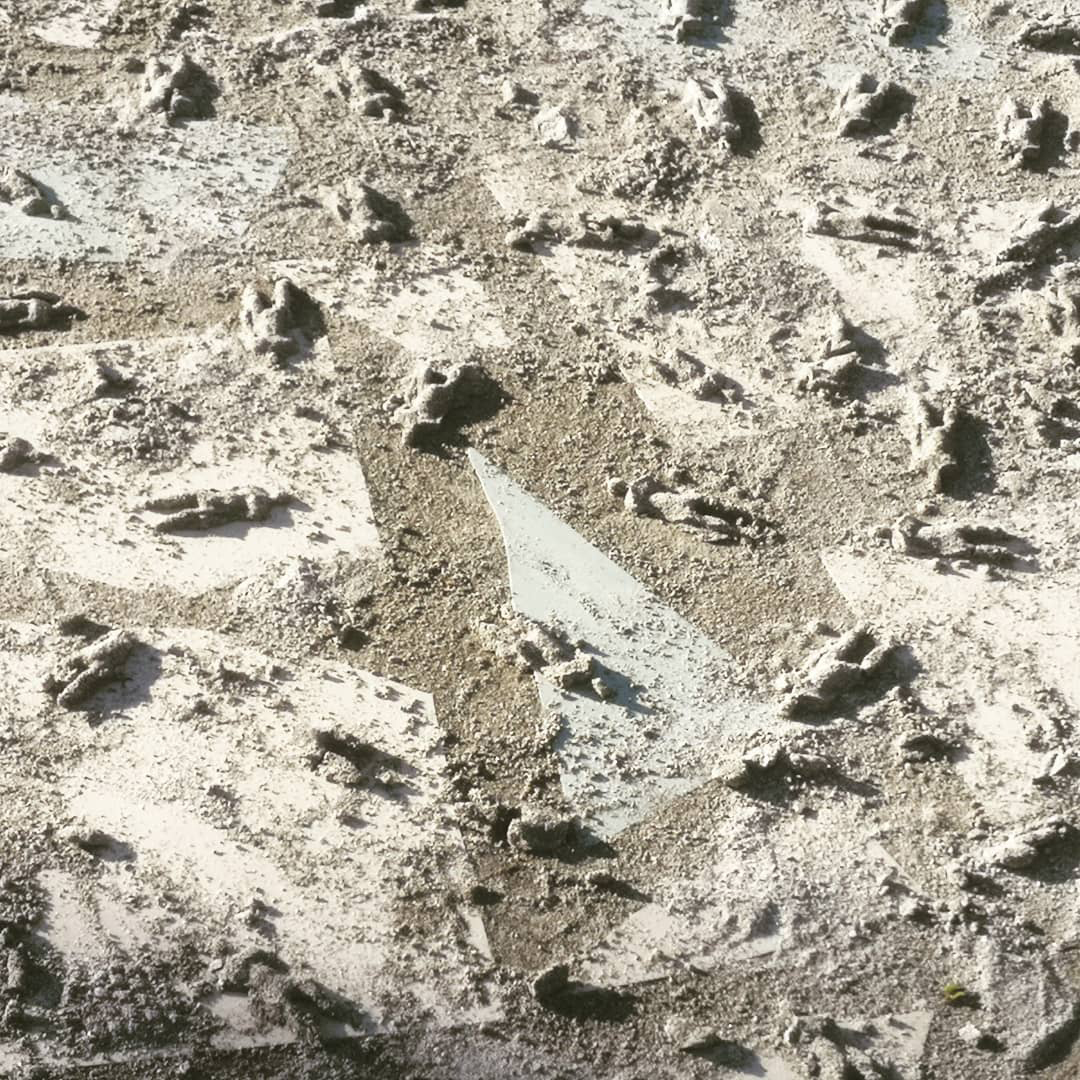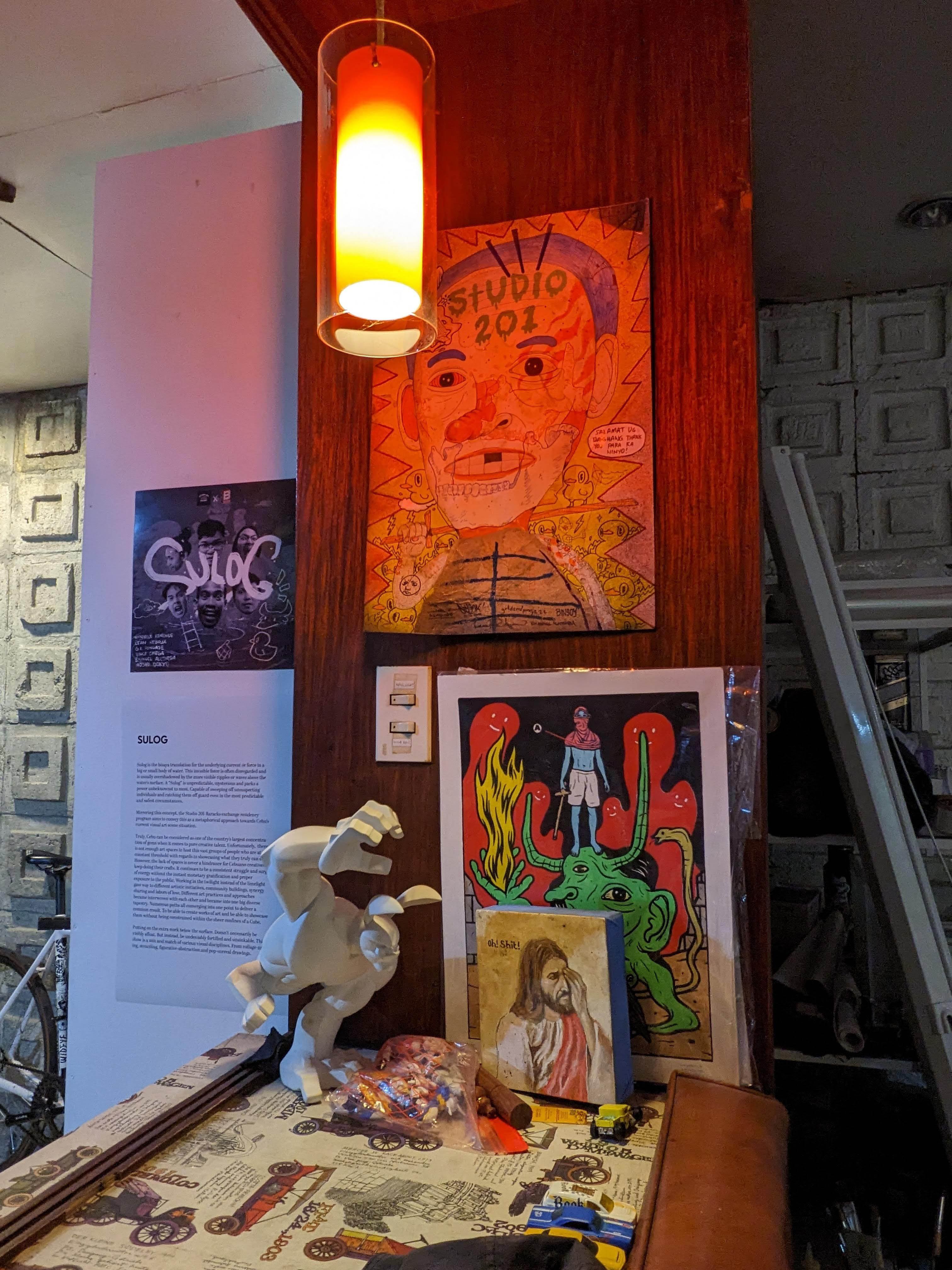It began with a 15-hour bike ride in 2021. Archie Oclos, Dennis Bato, and Tsarlyboy traveled each with their own two wheels to La Union. The three artists would eventually form half of Baraks, a six-piece collective managing an artist space in a quiet neighborhood in Quezon City.
Fast-forward to two years later, it was an overcast Saturday afternoon when I arrived at Baraks on two wheels (albeit a motorized one), unintentionally paralleling how the group-slash-residency started. AMC, another artist in the collective, welcomed me in. Archie and Dennis were also there while the rest (Tsarlyboy, Epi, and Apok) were out that day.
The warm welcome was heightened by Lakay, a large yellow Golden Retriever, who barked at me as a way of greeting.
“Maliit pa lang ‘yan nung nagstart kami, ngayon ang laki na niya! (He was just small when we started, now he's so big!),” I recall Archie saying.
Recall: an act that they did as they shared their stories that day, and an act that I did as I began writing a few days after. Our unrecorded conversations were hours-long, casual and free-flowing, as we rhapsodized over cold beers and salty meals.
A recollection: I brought up their first post on Instagram, dated July 13, 2022. I asked them how they found the house.
“Random lang, hindi talaga planado. (It was random and unplanned.)” Archie, Apok, and Tsarlyboy were biking around Quezon City when they chanced upon the house with a “For Rent” sign outside. Though the location scouting was unplanned, at that time they already had an idea to create an artist-run space.
Aside from the house having its own history – springing from the lives of its owners, from the social backdrop when it was constructed in the early 70s during the Martial Law era, and even from the movies and TV series filmed in it like Lovingly Yours, Helen – the house is also brimming with character, which is another factor that solidified their decision to make it their residency. Their plan to make it a homebase for artists was not an issue for the owners who are fortuitously also avid cyclists and art enthusiasts.
So much has already happened since they officially opened their gates in September. In just the last four months of 2022, they hosted multiple events – talks, film viewings, exhibits, and residencies. They noticed how the architecture of the space augments and adapts to their happenings, which adds a layer of appreciation to the house. During screenings or discussions for example, the wooden and stone walls and marble flooring enhance the sound but at the same time keep the hubbub contained inside.
“Punta ka next time ‘pag may event, makikita mo na nagtatransform din ‘yung space. (You should come by next time if there’s an event, you can see how the space transforms.)”
Looking back at the photos I took, the house seemed even more serendipitously built for Baraks. The floor pattern is reminiscent of ‘Alabok’, an artwork made by Dennis during one of his art residencies. The ephemeral piece was described as “a commentary on how humans give shape and meaning to a place in the way they occupy and move through it.”
As practicing artists who have first-hand experiences with the challenges attached to ideating and making art, they aim to offer a space for other artists, addressing their needs not only as artists, but also and more importantly, as humans. Baraks acknowledges that the artist also has a life outside artmaking. In essence, they want to provide a shelter for artists to live and work; it is an embodiment of Baraks as ‘barracks’.
“Artist ‘yung nagdedecide kung gaano siya katagal, pero flexible kami kung sakaling magrequest yung artist na i-extend ‘yun. Hindi rin kami nagdidictate ng schedule o output nila, self-directed ang residency namin. Pero syempre open naman kami kung kailangan ng input o feedback ng artist sa gawa nila. (The artist decides how long they’ll do it, but we are also flexible in case they request to extend it. We don’t dictate their schedule or output, our residency is self-directed. But if the artist needs input or feedback with their work, we’re open to providing it.)”
An artist’s capacity for self-directedness is something that is important for them. As a space and as a collective, they want to provide freedom and trust to their resident artists that they can manage working on their art while fulfilling personal obligations (i.e. as a freelancer, parent, etc.). Mindful of the latter, they are open to arrangements like having the artist’s family stay at the Baraks house.
They clarified too that they are not only limited to artists painting on canvas. Even the core six artists in Baraks are engaged in different and sometimes intersecting practices in the fields of graffiti, street art, writing, filmmaking, mixed media, collage, sculpture, and installation.
The variety reflects the practices of their visiting artists, and also extends to where they are from. So far, they have invited mixed media artist Buen Abrigo from Quezon, filmmaker Bagane Fiola from Davao, multimedia artist Mahaputra Vito from Jakarta, and Studio 201 composed of Wyndell Remonde, G.I Pongase, Emmanuel Alconera, Binsoy Lean Reboja, and Moshi dokyo from Argao, Cebu.
“Conscious kami sa pagpili ng artists namin, ‘yung sa tingin namin na may importanteng work na ginagawa pero hindi gaanong napapansin ng mainstream platforms. (We are conscious of the artists that we pick, they are the ones that we think are doing important work but are not noticed by mainstream platforms.)” AMC, a filmmaker originally from Cagayan de Oro, expounded in a later conversation that it is not working ‘against’ what is dominant in the current art scene, but acknowledging it and making intentional choices knowing what is sidelined by it.
Their mission as an alternative art space was also echoed by the artists from Studio 201 in their Instagram video. Speaking in Cebuano, they shared the concept of their show in Baraks last December. The English transcription reads:
“‘Sulog’ mirrors the invisible force underwater. We compared ourselves to the underwater current in terms of visibility in the art scene… We also aim to show the reality that Cebu lacks art spaces. However, this should not stop us from making art. Our push for art initiatives greatly helped us to look beyond confining our art in a gallery… Hopefully, our collaboration with Baraks can open more opportunities for other artists in Cebu or other islands to continue their artmaking even without their own proper art spaces.”
Recognizing the importance of their objective as an alternative art space, I asked them how they are making their operations sustainable in the long run.
“Fundamentally, artists are at the heart of this collective/space, so we understand the economics of how it is to be an artist in the current scene. What we are doing is a call to challenge arrangements imposed by art platforms that in essence cannot function without works from artists.”
They also added, “To be honest, we funded this using our own finances. Sa personal projects din namin, hindi lang namin iniisip sarili namin, nagbibigay din kami pabalik sa collective. (In our personal projects too, we don’t just think of ourselves, we give back to the collective.)”
Understanding more about the inner workings of their group, I asked if they have specific role assignments during events. Their answer reminded me of Lara Acuin and Con Cabrera’s collaborative work and individual contributions in curating Imelda Cajipe Endaya’s retrospective at CCP. In Baraks, they recognize and leverage each other’s strengths too (for example, writing for AMC and Dennis) but the members do not have clear-cut functions. They work together and take initiative if something needs to be done. It is again a recognition that artists are also humans and workers, that they might have other responsibilities that need their attention at the moment.
The way they explained it, their logo made sense. I can imagine the blocks sliding in with ease to fill in the spaces, like Tetris blocks.
“We like that, we never thought about it that way,” they said.
After some time, the skies turned dark, the conversations dwindled down, and the house went quiet again. I can’t recall the last topic that we spoke of, but I remember one of them saying at one point, “We are taking a risk with this, but it will be worth it.”
Baraks art space is located in Quezon City.
For upcoming projects, you may check their Instagram account @baraaaaaks.
Lk Rigor is currently pursuing MA Art Studies in UP Diliman. Aside from being a curator, she dreams of becoming a cat lady someday.





